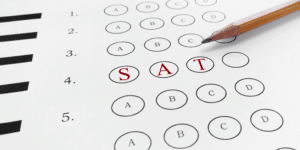It’s a bit mystifying that the ACT has the gall to include a Reading section on its test but not give students enough time to actually, you know, read the passages. The speed of ACT Reading is absolutely its defining characteristic and primary challenge, and any overview of the prep process for this section needs to start with the pace. Before we get into an overview of the preparation process, however, it’s important to quickly review the structure of ACT Reading. Fortunately, your favorite witty, brilliant Inspirica Pros test expert is here with a summary of what’s on the ACT Reading section.
Structure of the ACT Reading Section
The ACT Reading section consists of 40 questions that students must complete in 35 minutes. If that doesn’t sound too scary, make sure you keep in mind that the questions will ask you about details from a passage, and that many of them won’t tell you where in the text those details are located. When you think about needing to find the relevant information in the passage, read and process it, and then finally pick the answer choice that most closely matches it, all in less than a minute per question… well, it makes sense that many students find this section difficult.
The questions in ACT Reading are divided up evenly between four passages. These passages fall into two general categories: ‘Literary Narrative’ and ‘Informational’. Within those categories, however, test-takers will often see consistent genres.
-
- Literary narrative: This passage is typically the only one of the four that may be fictional, and it’s usually an excerpt from a novel, short story, or memoir.
- Social science: This type of informational passage is generally about some kind of politics-related organization, entity, or person, sometimes an NGO. As you can imagine, the text in this passage tends to be noticeably denser than that of the literary narrative passage.
- Humanities: Of all the informational passages, this sub-type has probably the widest range of possible topics. The common thread that unites them is that they’re typically about some cultural entity—a writer, for instance, or a TV show.
- Natural science: As the name suggests, this type of informational text deals with a topic related to the hard sciences—astronomy, biology, etc.—but is written in a way that makes it a bit more accessible than an academic research paper. Think ‘article from Popular Science’ and you’ll be on the right track.
The final important note about the structure of the ACT Reading section is that one of the four passages will always be split up into two shorter excerpts from two different texts, which will typically discuss different facets of the same central topic or theme. This comparison passage can be any of the four texts, and it will contain both questions that ask about only Passage A or only Passage B and questions that require you to compare and contrast aspects of both texts.
Content of the ACT Reading Section
Questions in the ACT Reading section fall into several different categories. The ACT separates them into questions that test ‘Key ideas and details’, ‘Craft and structure’, and ‘Integration of knowledge and ideas’. Those categories are juuuuuust north of useless, however, so we like to break what’s on the ACT Reading section down a little more clearly: broad questions and narrow questions.
Broad Questions
Put simply, broad questions are those that require you to read a substantial portion of the passage to be able to answer them. These questions may ask about the main idea of the entire passage or the passage’s structure, or they may ask you about individual details that are spread out throughout the text (the dreaded ‘EXCEPT’ question). Whatever the specific task that is required of you, you’ll typically need to have a solid understanding of most of the text in order to accomplish it, which is why we first want to prioritize…
Narrow Questions
This category includes all questions that can be answered with a relatively small amount of reading, ranging from a sentence to a couple of paragraphs. It’s important to note that just because a question is asking you for a specific and narrow piece of information, that doesn’t necessarily mean that it will tell you where to find that info. One of the ways the ACT makes these questions difficult is by requiring you to hunt through the passage text to find one particular fact. This is obviously difficult to do under time pressure, and we’ll talk in our overview of ACT Reading section strategies about how best to handle that difficulty.
_ _ _ _ _ _ _ _
That about covers our summary of the structure and content of the ACT Reading section. As you may have gathered, the most challenging aspect of the ACT Reading section isn’t what’s on it. Instead, the primary obstacle for most students is handling the aggressive pace of the section. To accomplish that, you have to learn the best strategies & techniques and practice them consistently. Fortunately, we know some people who can help with that. Head over to Inspirica Pros’ ACT headquarters to learn more about our prep options. Our squad of test gurus would love to help you crush the ACT.




